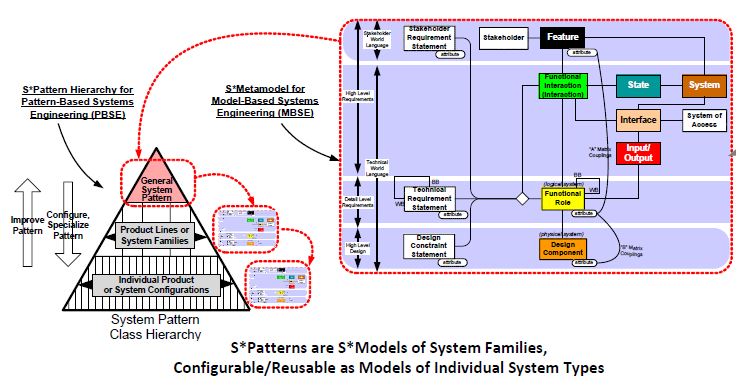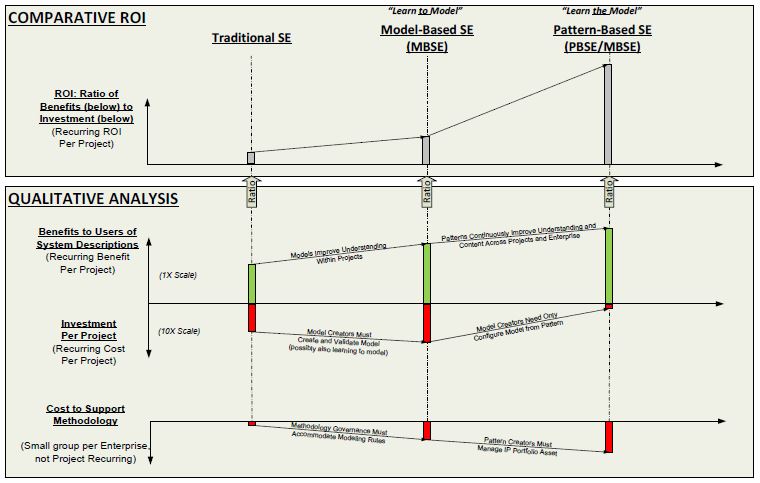Overview
Pattern-Based Systems Engineering (PBSE) Methodology is a form of Model-Based Systems Engineering (MBSE) based on use of the S*Metamodel. In this approach, re-usable, configurable S*Models (which are MBSE models conforming to the S*Metamodel, in any modeling language or toolset) are created, then used and re-used across a range of different system configurations or family members, and improved over time as the point of distillation of learning. These re-usable, configurable S*Models are called S*Patterns to emphasize their recurring use, and are model-based substantial extensions of earlier, pre-MBSE engineering patterns.
S*Models and S*Patterns contain Features, Interactions, Roles, States, Design Components, Interfaces, Requirements, Attributes thereof, couplings between them, and more. S*Patterns are constructed to cover a system configuration space bigger than single system model instances, and are sufficiently parameterized and abstracted to be configurable to more specific S*Models, and thereby reusable. S*Patterns are models of platforms, reference architectures, product lines, or system families:
S*Models and S*Patterns may be expressed in any system modeling language (e.g., SysML, IDEF, etc.) and managed in any COTS system modeling tool or repository, by an S*Metamodel mapping or profile.
PBSE builds on long historical work in patterns, now improved as MBSE models (many historical engineering patterns were not explicit MBSE models), expansion of pattern scope to whole system families, platforms, and domains (as opposed to smaller-scale localized patterns). An explicit foundation based on a stronger MBSE metamodel expresses systemic phenomena, critical to engineering applications needing a clearer connection to scientific understanding of systems phenomena.
Organizational/Learning Gains:
- Reduced recurring cost of modeling, along with shift of emphasis, from “learn how to model” (an abstract skill) to “learn the model (pattern)” in use by an enterprise, a more concrete knowledge of the enterprise’s products, simplifying the introduction of MBSE methods.
- A structured means of representing and accessing learning across organizational boundaries and different languages—technical, marketing, customer, production, life cycle support.
- Strong expression of fitness landscapes as the basis for selection, trades, improvements, decisions, innovations, configuration, and understanding of risk and failure.
Foundational Engineering Improvements:
- Explication of the System Phenomenon as a real world-based science and math foundation for systems engineering, amenable to systems science, connected to historical math/science models of engineering disciplines, encouraging discovery and expression of higher-level systemic phenomena.
- A detailed MBSE approach to Platform Management for system families and product lines and support of emerging standards and interests in product line engineering, reference architectures, architectural frameworks, ontologies.
- Strengthened semantic integration of system requirements with the rest of the model.
Engineering Process and Automation:
- Expression of key patterns in both Engineered Systems and Systems of Engineering, including the Embedded Intelligence (Management) Pattern, the Systems of Innovation Pattern generalization of ISO 15288, and its Agile Systems Life Cycle Pattern form.
- Very rapid generation of first draft configured system requirements and other fundamental systems engineering artifacts, of higher quality and completeness.
- Rapid generation of D-FMEA, A-FMEA, P-FMEA, and FTA analyses of risks on a more systematic and complete basis, more deeply integrated with the rest of the system model.
Compatibility / Ease of Integration
- Compatibility with contemporary modeling language standards.
- Direct mapping into contemporary modeling tools, PLM information systems, and other COTS and enterprise systems, increasing the value of existing information technologies.
- Deeper support for federated data across differing information systems, for integration with emerging open systems life cycle (OSLC) standard technologies.
- Strong expression of life cycle and operational states of systems
Applied in award-winning INCOSE papers, S*MBSE models have been practiced for two decades, across a variety of domains in commercial, defense, and institutional environments:
Tool Support
PBSE and its supporting S*Metamodel are tool-independent by intention. Substantially any COTS modeling, engineering, or PLM tool can be made to support PBSE by the use of an S*Metamodel Map for the specific COTS tool. Such mappings have already been created for a number of tools, including IBM/Rational DOORS™, Siemens Team Center™ Systems Engineering, Dassault Systemes ENOVIA™, Sparx Enterprise Architect™ for SysML®, IBM Rhapsody for SysML®, generic standard SysML, and others. Each such mapping is a detail specification of the formal mapping of S*Metamodel classes, relationships, and attributes into a specific schema native to the target tool or information system, along with supporting configuration information.
Offering/Availability
The general PBSE approach to enhanced MBSE is being shared through and explored by the members of the Patterns Working Group of the INCOSE MBSE Initiative. This cross-industries team has been and continues pursuing a number of PBSE applications and projects (including joint projects with other INCOSE working groups) which are shared through the INCOSE MBSE Challenge Team’s MBSE wiki / web site posted resources, reference, and information assets. Refer to the Resources below.
Where commercial support may be requested, ICTT System Sciences and its partners provide related services, and the third party COTS tools noted above are supported by their commercial suppliers. S*Modeling elements are also taught as systems competencies for engineering undergraduates at Rose-Hulman Institute of Technology, the original academic parent of ICTT.
Resources
Summary of PBSE Methodology:
- Schindel, W., et al, “Pattern-Based Systems Engineering (PBSE) Based on S*MBSE Models” INCOSE MBSE Patterns Working Group, 2015. (Click here for this article, and more references, examples.)
Applications of PBSE:
- Bradley, J., Hughes, M., and Schindel, W., “Optimizing Delivery of Global Pharmaceutical Packaging Solutions, Using Systems Engineering Patterns” Proceedings of the INCOSE 2010 International Symposium, 2010.
- Cook, D., and Schindel, W., “Utilizing MBSE Patterns to Accelerate System Verification”, in Proc. of the INCOSE 2015 International Symposium, Seattle, WA, July, 2015.
- Peterson, T., and Schindel, W., “Pattern-Based Systems Engineering: Leveraging Model-Based Systems Engineering for Cyber-Physical Systems”, Proc. of NDIA GVSETS Conference, 2014.
- Schindel, W., and Smith, V., “Results of applying a families-of-systems approach to systems engineering of product line families”, SAE International, Technical Report 2002-01-3086, 2002.
- Schindel, W., and Peterson, T., “Introduction to Pattern-Based Systems Engineering (PBSE): Leveraging MBSE Techniques”, in Proc. of INCOSE 2013 International Symposium, Tutorial, June, 2013.
- Schindel, W., Lewis, S., Sherey, J., Sanyal, S., “Accelerating MBSE Impacts Across the Enterprise: Model-Based S*Patterns”, in Proc. of INCOSE 2015 International Symposium, July, 2015.
Impact of Formal Interaction Models:
- Schindel, W., “Requirements Statements Are Transfer Functions: An Insight From Model-Based Systems Engineering”, Proceedings of INCOSE 2005 International Symposium, 2005.
- Schindel, W., “System Interactions: Making the Heart of Systems More Visible”, Proc. of INCOSE Great Lakes Regional Conference, 2013.
- Simoni, M., et al, “Practicing and Assessing Formal Systems Competencies in ECE Senior Design”, in Proc. of American Society for Engineering Education 2014 Conference, 2014.
The INCOSE MBSE Patterns Working Group
- MBSE wiki / web site of Patterns Challenge Team:
- Schindel, W., “Failure Analysis: Insights from Model-Based Systems Engineering”, Proc. of INCOSE International Symposium, 2010.
- Schindel, W., “What Is the Smallest Model of a System?”, Proc. of the INCOSE 2011 International Symposium, International Council on Systems Engineering (2011).



